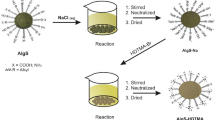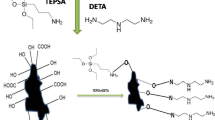Abstract
The present work investigates the potential use of sodium silicate generated from rice husk ash and functionalized with cetyltrimethylammonium bromide (CTAB), for adsorption of Congo Red (CR) and Naphthol Green B (NGB) from aqueous solutions. The adsorption capacity of raw rice husk, calcinated rice husk (673, 873, 1073, and 1273 K), and functionalized sodium silicate were investigated. They were characterized by SEM, FTIR, TGA–DSC, and zeta potential analysis. The results showed that sodium silicate adsorption capacity and the functionalization effect were maximum at 873 K. The optimum adsorption conditions for CR and NGB onto Na2SiO3-CTAB adsorbent are as follows: contact time 30 min, pH 6, adsorbent dosage of 0.1 g, temperature 303 K, and initial dye concentration of 50 mg/L and 150 mg/L for NGB and CR, respectively. The maximum adsorption capacities for CR and NGB were recorded at 73.04 and 86.59 mg/g at 303 K, respectively. The pseudo-first-order kinetic model described well the adsorption of these dyes. However, Freundlich and Liu isotherm models described well the adsorption of NGB and CR, respectively. According to thermodynamic parameters, these adsorptions were endothermic and involved physical processes. Desorption capacities of 96.21% (for CR) and 92.21% (for NGB) were reached using 50% acetone solution. A maximum of four adsorption/desorption cycles was carried out. Thus, it can be concluded that sodium silicate modified with CTAB after calcination at 873 K is a potential low-cost adsorbent and renewable sorbent for the removal of dyes from industrial wastewater.
Graphical Abstract











Similar content being viewed by others
Data availability
All data generated or analyzed during this study are included in this published article [and its supplementary information files].
References
N.R. Palapa, T. Normah, R. Taher, A. Mohadi, A. Lesbani. Rachmat, Effectivity of Indonesian rice husk as an adsorbent for removing Congo red from aqueous solutions. Environ. Nat. Resour. J. 19, 255–265 (2021). https://doi.org/10.32526/ennrj/19/2020232
S. Kumar, P. Sangwan, R.M.V. Dhankhar, S. Bidra, Utilization of rice husk and their ash: a review. Res. J. Chem. Environ. Sci. 1(5), 126–129 (2013)
E. Kiefer, L. Sigg, P. Schosseler, Chemical and spectroscopic characterization of algae surfaces. Environ. Sci. Technol. 31, 759–764 (1997). https://doi.org/10.1021/es960415d
R. Riahi-Madvaar, M.A. Taher, H. Fazelirad, Synthesis and characterization of magnetic halloysite-iron oxide nanocomposite and its application for naphthol green B removal. Appl. Clay Sci. 137, 101–106 (2017). https://doi.org/10.1016/j.clay.2016.12.019
C. Bamroongwongdee, S. Suwannee, M. Kongsomsaksiri, Adsorption of Congo red from aqueous solution by surfactant-modified rice husk: kinetic, isotherm and thermodynamic analysis, Songklanakarin. J. Sci. Technol. 41, 1076–1083 (2019). https://doi.org/10.14456/sjst-psu.2019.135
Z. Bouberka, S. Kacha, M. Kameche, S. Elmaleh, Z. Derriche, Sorption study of an acid dye from an aqueous solutions using modified clays. J. Hazard. Mater. 119, 117–124 (2005). https://doi.org/10.1016/j.jhazmat.2004.11.026
K.D. Belaid, S. Kacha, Study of the kinetics and thermodynamics of the adsorption of a basic dye on sawdust. Rev. Des Sci. l’Eau. 24, 131–144 (2011). https://doi.org/10.7202/1006107ar
E.C. Lima, A. Hosseini-Bandegharaei, J.C. Moreno-Piraján, I. Anastopoulos, A critical review of the estimation of the thermodynamic parameters on adsorption equilibria. Wrong use of equilibrium constant in the Van’t Hoof equation for calculation of thermodynamic parameters of adsorption. J. Mol. Liq. 273, 425–434 (2019). https://doi.org/10.1016/j.molliq.2018.10.048
V.H. Le, C.N.H. Thuc, H.H. Thuc, Synthesis of silica nanoparticles from Vietnamese rice husk by sol–gel method. Nanoscale Res. Lett. 8, 1–10 (2013). https://doi.org/10.1186/1556-276x-8-58
J.M. Kepdieu, C.N. Djangang, J.R. Njimou, S.A. Maicaneanu, J.R. Mache, G. Tchanang, Low-cost pathways to synthesize silica-smectite clay-based composites. Silicon. 15(17), 7345–7356 (2023). https://doi.org/10.21203/rs.3.rs-2452721/v1
L. Xiong, E.H. Sekiya, S. Wada, K. Saito, Facile catalytic combustion of rice husk and burning temperature dependence of the ashes. ACS Appl. Mater. Interfaces 1, 2509–2518 (2009). https://doi.org/10.1021/am9004623
M.C.D. Dominic, P.M.S. Begum, R. Joseph, D. Joseph, P. Kumar, E.P. Ayswarya, Synthesis, characterization and application of rice husk nanosilica in natural rubber. Int. J. Sci. Environ. Technol. 2, 1027–1035 (2013)
M.O. Aremu, A.O. Arinkoola, I.A. Olowonyo, K.K. Salam, Improved phenol sequestration from aqueous solution using silver nanoparticle modified Palm Kernel Shell Activated Carbon. Heliyon. 6, e04492 (2020). https://doi.org/10.1016/j.heliyon.2020.e04492
O.H. Lin, T.G. Yee, N.A.N.N. Azza, M.M. Safwan, A.R. Villagracia, C.K. Mern, M.M.A.B. Abdullah, Utilization of modified palm kernel shell for biocomposites production. Key Eng. Mater. 700, 60–69 (2016). https://doi.org/10.4028/www.scientific.net/KEM.700.60
A.K. Chowdhury, A.D. Sarkar, A. Bandyopadhyay, Rice husk ash as a low cost adsorbent for the removal of Methylene Blue and Congo Red in aqueous phases. Clean - Soil, Air, Water. 37, 581–591 (2009). https://doi.org/10.1002/clen.200900051
M.C.D. Ngaha, E. Njanja, G. Doungmo, A. Tamo Kamdem, I.K. Tonle, Indigo carmine and 2,6-dichlorophenolindophenol removal using cetyltrimethylammonium bromide-modified palm oil fiber: adsorption isotherms and mass transfer kinetics, Int. J. Biomater. 2019 (2019). https://doi.org/10.1155/2019/6862825.
K. Farooque, M. Zaman, E. Halim, S. Islam, M. Hossain, Y. Mollah, A. Mahmood, Characterization and utilization of rice husk ash (RHA) from rice mill of Bangladesh, Bangladesh. J. Sci. Ind. Res. 44, 157–162 (1970). https://doi.org/10.3329/bjsir.v44i2.3666
X. Liu, J. Jiang, H. Zhang, M. Li, Y. Wu, L. Guo, W. Wang, P. Duan, W. Zhang, Z. Zhang, Thermal stability and microstructure of metakaolin-based geopolymer blended with rice husk ash. Appl. Clay Sci. 196, 105769 (2020). https://doi.org/10.1016/j.clay.2020.105769
F. Adam, S. Balakrishnan, P.-L. Wong, Rice husk ash silica as a support material for ruthenium based heterogenous catalyst. J. Phys. Sci. 17, 1–13 (2006)
W.A.P.J. Premaratne, W.M.G.I. Priyadarshana, S.H.P. Gunawardena, A.A.P. De Alwis, Synthesis of nanosilica from paddy husk ash and their surface functionalization. J. Sci. Univ. Kelaniya Sri Lanka. 8, 33 (2014). https://doi.org/10.4038/josuk.v8i0.7238
M.A. Zenasni, B. Meroufel, A. Merlin, B. George, Adsorption of Congo Red from aqueous solution using CTAB-Kaolin from Bechar Algeria. J. Surf. Eng. Mater. Adv. Technol. 04, 332–341 (2014). https://doi.org/10.4236/jsemat.2014.46037
J. Goworek, A. Kierys, W. Gac, A. Borówka, R. Kusak, Thermal degradation of CTAB in as-synthesized MCM-41. J. Therm. Anal. Calorim. 96, 375–382 (2009). https://doi.org/10.1007/s10973-008-9055-6
S.E. Rizk, M.M. Hamed, Batch sorption of iron complex dye, naphthol green B, from wastewater on charcoal, kaolinite, and Tafla. Desalin. Water Treat. 56, 1536–1546 (2015). https://doi.org/10.1080/19443994.2014.954004
Z. Zhang, L. Moghaddam, I.M. O’Hara, W.O.S. Doherty, Congo Red adsorption by ball-milled sugarcane bagasse. Chem. Eng. J. 178, 122–128 (2011). https://doi.org/10.1016/j.cej.2011.10.024
S. Bhowmik, V. Chakraborty, P. Das, Batch adsorption of indigo carmine on activated carbon prepared from sawdust: a comparative study and optimization of operating conditions using Response Surface Methodology. Results Surf Interfaces. 3, 100011 (2021). https://doi.org/10.1016/j.rsurfi.2021.100011
Y. Zhang, H. Xu, S. Ma, M. Chen, L. Tian, G. Gou, Y. Chen, A research on the removal characteristics of naphthol Green B from wastewater using nanomaterials nZVI/CS/APT. Phys. Chem. Liq. 60, 219–232 (2022). https://doi.org/10.1080/00319104.2021.1939344
A.A. Ali, S.R. El-Sayed, S.A. Shama, T.Y. Mohamed, A.S. Amin, Fabrication and characterization of cerium oxide nanoparticles for the removal of naphthol green b dye. Desalin. Water Treat. 204, 124–135 (2020). https://doi.org/10.5004/dwt.2020.26245
B. Acemioǧlu, Adsorption of Congo red from aqueous solution onto calcium-rich fly ash. J. Colloid Interface Sci. 274, 371–379 (2004). https://doi.org/10.1016/j.jcis.2004.03.019
D. Adamczyk, E. Bezak-Mazur, Adsorption Naphtol Green B on activated carbon F-300. Ecol. Chem. Eng. A 19, 1123–1131 (2012). https://doi.org/10.2428/ecea.2012.19(09)108
A. Borhan, S. Yusup, J.W. Lim, P.L. Show, Characterization and modelling studies of activated carbon produced from rubber-seed shell using KOH for CO2 adsorption, Processes. 7 (2019). https://doi.org/10.3390/pr7110855.
S. Dawood, T.K. Sen, Removal of anionic dye Congo red from aqueous solution by raw pine and acid-treated pine cone powder as adsorbent: equilibrium, thermodynamic, kinetics, mechanism and process design. Water Res. 46, 1933–1946 (2012). https://doi.org/10.1016/j.watres.2012.01.009
Z. Hu, H. Chen, F. Ji, S. Yuan, Removal of Congo Red from aqueous solution by cattail root. J. Hazard. Mater. 173, 292–297 (2010). https://doi.org/10.1016/j.jhazmat.2009.08.082
M.F. Attallah, I.M. Ahmed, M.M. Hamed, Treatment of industrial wastewater containing Congo Red and Naphthol Green B using low-cost adsorbent. Environ. Sci. Pollut. Res. 20, 1106–1116 (2013). https://doi.org/10.1007/s11356-012-0947-4
A. Naphtali Odogu, K. Daouda, L. Paul Keilah, G. AgborTabi, L. Ngouateu Rene, N. Julius Nsami, K. JosophMbadcam, Effect of doping activated carbon based Ricinodendron Heudelotti shells with AgNPs on the adsorption of indigo carmine and its antibacterial properties. Arab. J. Chem. 13, 5241–5253 (2020). https://doi.org/10.1016/j.arabjc.2020.03.002
Z. Harrache, M. Abbas, T. Aksil, M. Trari, Thermodynamic and kinetics studies on adsorption of Indigo Carmine from aqueous solution by activated carbon. Microchem. J. 144, 180–189 (2019). https://doi.org/10.1016/j.microc.2018.09.004
R. Han, D. Ding, Y. Xu, W. Zou, Y. Wang, Y. Li, L. Zou, Use of rice husk for the adsorption of Congo red from aqueous solution in column mode. Bioresour. Technol. 99, 2938–2946 (2008). https://doi.org/10.1016/j.biortech.2007.06.027
N. Mahmud, A. Benamor, Magnetic iron oxide kaolinite nanocomposite for effective removal of Congo Red dye: adsorption, kinetics, and thermodynamics studies. Water Conserv. Sci. Eng. 8, 1–19 (2023). https://doi.org/10.1007/s41101-023-00207-x
A.A. Aryee, R. Han, L. Qu, CTAB-modified peanut husk pre-treated with KMnO4 as an eco-friendly adsorbent for the uptake of Congo red in solution: adsorption and mechanism study, Environ. Sci. Pollut. Res. (2023) 1–14. https://doi.org/10.1007/s11356-023-31565-7.
N. Ardhaoui, W. Sassi, R. Msaadi, N. Rouge, S. Ammar, A. Nafady, J.Y. Hihn, Adsorption and photocatalysis properties of perlite during oxytetracycline removal. Water Air Soil Pollut. 234, 1–13 (2023). https://doi.org/10.1007/s11270-023-06709-7
M. Malhotra, S. Suresh, A. Garg, Tea waste derived activated carbon for the adsorption of sodium diclofenac from wastewater: adsorbent characteristics, adsorption isotherms, kinetics, and thermodynamics. Environ. Sci. Pollut. Res. 25, 32210–32220 (2018). https://doi.org/10.1007/s11356-018-3148-y
G.Z. Kyzas, N.K. Lazaridis, A.C. Mitropoulos, Removal of dyes from aqueous solutions with untreated coffee residues as potential low-cost adsorbents: equilibrium, reuse and thermodynamic approach. Chem. Eng. J. 189–190, 148–159 (2012). https://doi.org/10.1016/j.cej.2012.02.045
E. Njikam, S. Schiewer, Optimization and kinetic modeling of cadmium desorption from citrus peels: a process for biosorbent regeneration. J. Hazard. Mater. 213–214, 242–248 (2012). https://doi.org/10.1016/j.jhazmat.2012.01.084
Funding
This work was funded by Coordination for the Improvement of Higher Education Personnel/CAPES (CAPES-PRINT Program). This work was financially supported by University of Rouen Normandy, INSA Rouen Normandy, the Centre National de la Recherche Scientifique (CNRS), European Regional Development Fund (ERDF), Labex SynOrg (ANR-11-LABX-0029), Carnot Institute I2C, the Graduate School for Research XL-Chem (ANR-18-EURE-0020 XL CHEM), the MOPG4 program (114722U), and Region Normandie.
Author information
Authors and Affiliations
Contributions
All authors contributed to the study conception and design. Material preparation, data collection and analysis were performed by Albert Mandjewil, Patrick Tsopbou Ngueagni, Ngoungoure Mandou Fadimatou, and Jean Mermoz Siewe. The first draft of the manuscript was written by Julien Vieillard, Guilherme Luiz Dotto, Emmanuel Djoufac Woumfo, and Patrick Nkuigue Fotsing, and all authors commented on previous versions of the manuscript. All authors read and approved the final manuscript.
Corresponding authors
Ethics declarations
Competing interests
The authors declare no competing interests.
Supplementary Information
Below is the link to the electronic supplementary material.
Rights and permissions
Springer Nature or its licensor (e.g. a society or other partner) holds exclusive rights to this article under a publishing agreement with the author(s) or other rightsholder(s); author self-archiving of the accepted manuscript version of this article is solely governed by the terms of such publishing agreement and applicable law.
About this article
Cite this article
Fadimatou, N.M., Fotsing, P.N., Mandjewil, A. et al. Cetyltrimethylammonium bromide (CTAB) functionalization of sodium silicate from rice husks ash for Naphthol Green B and Congo Red adsorption. emergent mater. (2024). https://doi.org/10.1007/s42247-024-00655-8
Received:
Accepted:
Published:
DOI: https://doi.org/10.1007/s42247-024-00655-8




